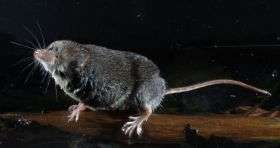How water shrews find prey in the dark

Shrews are tiny mammals that have been widely characterized as simple and primitive. This traditional view is challenged by a new study of the hunting methods of an aquatic member of the species, the water shrew. The research reveals that the small animal possesses remarkably sophisticated methods for detecting prey that allow it to catch small fish and aquatic insects as readily in the dark as in daylight.
It is a skill set that the water shrew really needs. About half the size of a mouse, water shrews have such a high metabolism that they must eat more than their weight daily and can starve to death in half a day if they can't find anything to eat. As a result, water shrews are formidable predators ounce for ounce.
"Water shrews do much of their hunting at night, so I began wondering how they can identify their prey in nearly total darkness," says Ken Catania, the associate professor of biological sciences at Vanderbilt who headed the study.
Catania teamed up with James Hare and Kevin Campbell at the University of Manitoba and used a high-speed infrared video camera to answer this question. The results of their study are reported in a paper titled "Water shrews detect movement, shape, and smell to find prey underwater" published Jan. 9 in the Proceedings of the National Academy of Sciences.
"Our research confirms that shrews in general, and water shrews in particular, are marvels of adaptation, with specializations and behaviors that put many other mammals to shame," says Catania.
The researchers needed a high-speed camera because of the water shrew's lightning-fast reflexes: It can launch an attack less than a 50th of a second after detecting the presence of prey, and it opens it mouth in preparation to take a bite in 20th of a second. To determine how the shrews hunt in the dark, the scientists also had to monitor their behavior in the infrared portion of the spectrum, which is beyond the shrew's visual range.
Their observations revealed that the tiny animals can catch prey just as quickly and efficiently at night as they do during the day and determined that they use three basic methods to do so. Working in darkness, water shrews:
-- Detect water movements caused when prey animals try to swim away;
-- Identify the shape of prey species using their whiskers;
-- Use their sense of smell underwater by blowing air bubbles out of their nose and then re-inhaling them.
Catania had discovered the third of these methods—the shrews' ability to follow scent trails underwater by exhaling air bubbles and then re-inhaling them—in a 2006 study published in the journal Nature. This ability allows diving water shrews to literally sniff out the general location of underwater prey.
In the current paper, the researchers discovered that the water shrews use two additional methods to zero in on toothsome targets. "This combination of methods poses a serious conundrum for prey," Catania observes. "If they freeze, they risk detection from touch or olfaction. But if they try to swim away, they generate water currents that can reveal their location."
After observing the water shrews' natural hunting behavior in nearly total darkness, the researchers devised a series of experiments to identify the specific detection methods that the tiny hunters use and to rule out some others.
By recording audible and ultrasonic calls, the researchers were able to rule out the possibility that the tiny shrews use of sonar, echolocation or electrical sensitivity (electroreception) to find prey.
To test water shrew's response to water currents, Howthe researchers equipped a small, glass-bottomed aquarium with several small water jets. They put individual water shrews into the chamber and videotaped their response as they turned different jets on and off. They found that the shrews repeatedly attacked brief, sudden water movements designed to simulate disturbances caused by escaping prey.
To test the water shrews' ability to identify prey by their shape, Catania and his colleagues created fish-shaped silicon objects, mixed them with similarly sized rectangular and cylindrical pieces of silicon and put them in the aquarium with the shrews. Then they observed as the shrews' generally ignored the geometric shaped objects but snapped up the fish-shaped targets after nudging them with their whiskers.
The researchers also determined that motion also triggered attacks, even when the moving targets did not have a realistic fish shape. They created moving targets by inserting a small piece of iron into pieces of silicon and used a magnet placed under the tank to make them move.
"One of the difficulties in doing these experiments was that it doesn't take the shrews long to figure out that our targets are not real fish. You can only fool them a few times," Catania reports.
The research was funded by a NSF Career Award and a MacArthur Award to Catania and a Natural Sciences and Engineering Research Council of Canada Discovery grant to Campbell and Hare.
Source: By David F. Salisbury,
















